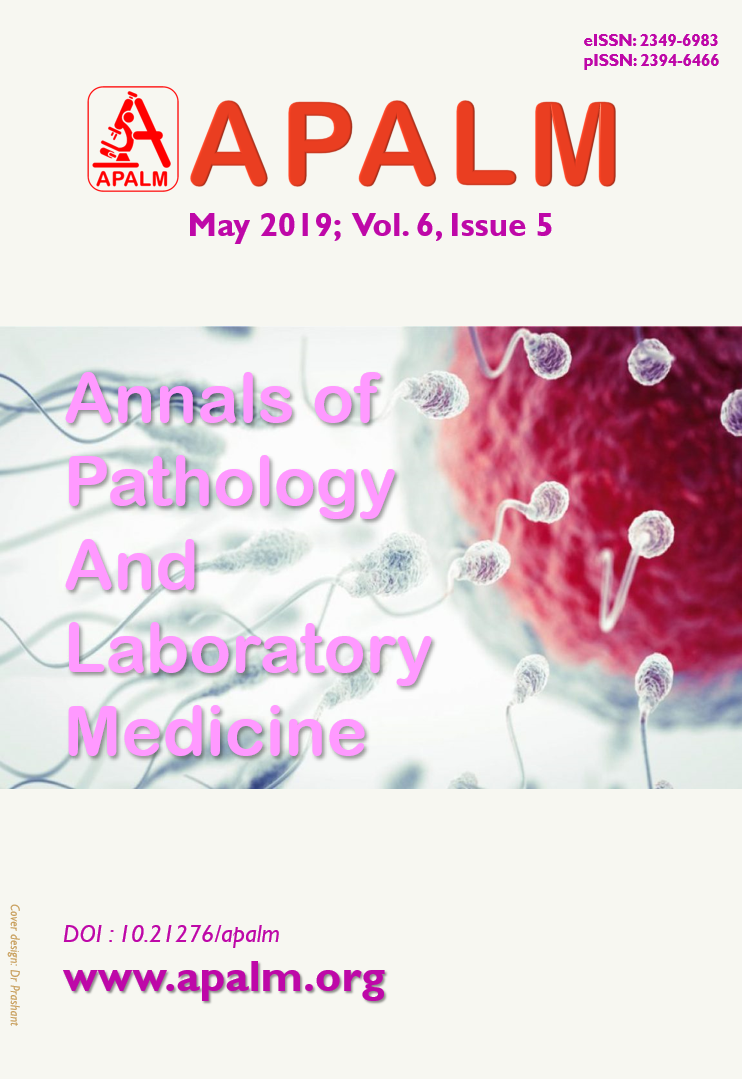Red Cell Distribution Width and Its Relationship with Microalbuminuria Among Patients with Essential Hypertension
DOI:
https://doi.org/10.21276/apalm.2363Keywords:
Essential hypertension, microalbuminuria, RDWAbstract
Background: Elevated Red Cell Distribution Width (RDW) is an indicator of renal damage in hypertensive patients. Microalbuminuria (MAU) is an indicator of risk for cardiovascular complications and progressive renal damage in patients with diabetes and also hypertension.
Objectives: 1. Determine RDW and microalbuminuria in hypertensive patients. 2. Determine RDW levels in hypertensive patients with microalbuminuria and without microalbuminuria and to evaluate the relationship between these two parameters.
Methodology: Our prospective study was conducted on 98 patients attending outpatient clinic for blood pressure check up and treatment. For measurement of RDW - 2 ml blood was collected by clean venepuncture and collected in EDTA tube and determined RDW by automatic cell counter (sysmex KX-21) and for microalbuminuria - Early morning urine samples were collected and microalbumin determined by immunoturbidimetry. Statistical analysis were done using SPSS version — 16.0.
Results: A total of 98 patients were included in the present study with age ranging from 30 — 86 year. All the patients were known hypertensive under treatment and 54 of them also had associated diabetes mellitus. The male to female ratio of the sample was 29:69. Out of the total 98 patients, 58 (59.2%) presented with microalbuminuria and 23 (23.5%) patients had RDW value above normal. Out of the 58 patients with microalbuminuria, 17 (29.3%) patients had RDW value above normal but only 6 (15%) patients out of 40 patients without microalbuminuria had RDW value above normal.
Conclusion: Though we could not find out a direct relationship between RDW and MAU, some of the individual patients with MAU had high RDW compared to patients without MAU. As RDW is routinely done as part of complete blood counts in all patients, if its value is high in hypertensive patients, we can workup the patient for microalbuminuria. Early detection and treatment can avoid complications in these patients.
References
2. Pontremoli R, Leoncini G, Ravera M, Viazzi F, Vettoretti S, Ratto E, Parodi D, Tomolillo C, Deferrari G. Microalbuminuria, cardiovascular, and renal risk in primary hypertension. J Am Soc Nephrol 2002;13:169-72.
3. Leoncini G, Viazzi F, Parodi D, Ratto E, Vettoretti S, Vaccaro V, Ravera M, Deferrari G, Pontremoli R. Mild renal dysfunction and cardiovascular risk in hypertensive patients. J Am Soc Nephrol 2004;15:88-90.
4. Lippi G, Targher G, Montagnana M, Salvagno GL, Zoppini G, Guidi GC. Relation between red cell distribution width and inflammatory biomarkers in a large cohort of unselected outpatients. Arch Pathol Lab Med 2009;133:628-32.
5. Tanindi A, Topal FE, Topal F, Celik B. Red cell distribution width in patients with prehypertension and hypertension. Blood Press 2012;21:177-81.
6. Li ZZ, Chen L, Yuan H, Zhou T, Kuang ZM. Relationship between red blood cell distribution width and early-stage renal function damage in patients with essential hypertension. J Hypertens 2014;32:2450-5.
7. Wen Y. High red blood cell distribution width is closely associated with risk of carotid artery atherosclerosis in patients with hypertension. Exp Clin Cardiol 2010;15:37-40.
8. Crippa G. Microalbuminuria in essential hypertension. Journal of Human Hypertension 2002;16:S74-S77.
9. Jenson JS, Feldt-Rasmussen B, Strandgaard S, Schroll M, Borch-Johnsen K. Arterial hypertension, microalbuminuria, and risk of ischemic heart disease. Hypertension 2000;35:898-903.
10. Klausen K, Borch-Johnsen K, Feldt-Rasmussen B, Jensen G, Clausen P, Scharling H et al. Very low levels of microalbuminuria are associated with increased risk of coronary heart disease and death independently of renal function, hypertension, and diabetes. Circulation 2004;110:32-5.
11. Pusuroglu H, Akgul O, ERturk M, Surgit O, Tasbulak O, Akkaya E, et al. Red cell distribution width and end organ damage in patients with systo-diastolic hypertension. Arch Med Sci 2016;12:319-25.
12. Tonelli M, Sacks F, Arnold M, Moye L, Davis B, Pfeffer M. Relation between red cell distribution width and cardiovascular event rate in people with coronary disease. Circulation 2008;117:163-8.
13. Afonso L, Zalawadiya SK, Veeranna V, Panaich SS, Niraj A, Jacob S. Relationship between red cell distribution width and microalbuminuria: a population-based study of multiethnic representative US adults. Nephron Clin Pract 2011;119:277-82.
14. Tharayil Kattil Jithesh, Riju Mathew, Vidyadharan Jayapal, Thankappan Vijajakumar. Microalbuminuria and red cell distribution width as predictive markers of renal involvement in hypertension. Int J Health Rehabil sci 2012;1:99-106.
15. Mathew R, Pai VR, Vijayakumar T. Comparison of microalbuminuria with biochemical and haematological parameters as a marker for renal involvement in patients at high risk for chronic kidney disease — A pilot study. International Journal of Science and Engineering research 2014;5:97-100.
Downloads
Published
Issue
Section
License
Copyright (c) 2019 Akhshaya Ponsuba T, Manimaran D, Desigamani K, Sangeetha B S, Rajesh H, Sheeja J

This work is licensed under a Creative Commons Attribution 4.0 International License.
Authors who publish with this journal agree to the following terms:
- Authors retain copyright and grant the journal right of first publication with the work simultaneously licensed under a Creative Commons Attribution License that allows others to share the work with an acknowledgement of the work's authorship and initial publication in this journal.
- Authors are able to enter into separate, additional contractual arrangements for the non-exclusive distribution of the journal's published version of the work (e.g., post it to an institutional repository or publish it in a book), with an acknowledgement of its initial publication in this journal.
- Authors are permitted and encouraged to post their work online (e.g., in institutional repositories or on their website) prior to and during the submission process, as it can lead to productive exchanges, as well as earlier and greater citation of published work (See The Effect of Open Access at http://opcit.eprints.org/oacitation-biblio.html).










